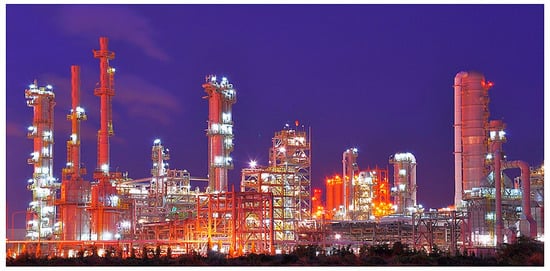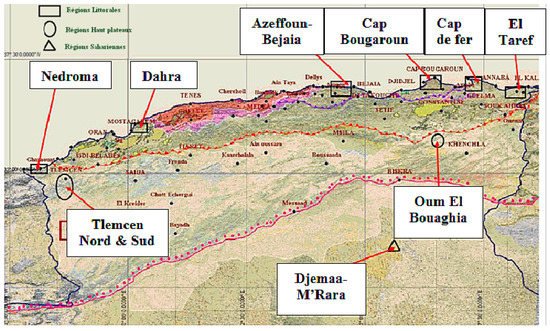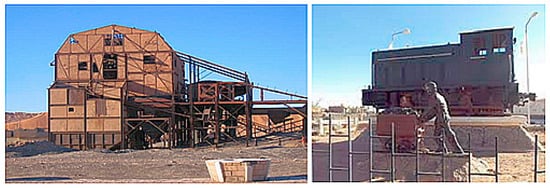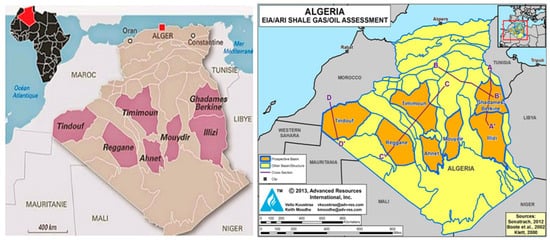You're using an outdated browser. Please upgrade to a modern browser for the best experience.
Please note this is a comparison between Version 1 by Youcef Himri and Version 2 by Catherine Yang.
Algeria is a wealthy country with natural resources, namely, nuclear, renewable, and non-renewable sources. The non-renewable energy sources are considered the lion’s share for energy production (98%). Algeria’s efforts to ensure and strengthen its energy security will take an important step in the coming decades by commissioning new energy infrastructure based on intensive use of water, coal, nuclear, non-renewable, and renewable sources.
- nuclear
- renewable energy
- solar
- water
- wind energy
1. Natural and Shale Gas Energy
Algeria is among the top 10 natural gas producers in the world, as the eighth largest natural gas (NG) exporter, and the third in terms of recoverable shale gas resources [1]. Indeed, according to the BP Statistical Energy Review 2021, Algeria has proven NG reserves of 2.3 × 1018 m3 with NG production of 81.5 × 1012 m3 and consumption of 43.1 × 1012 m3 in the year 2020. With the start of the LNG plant at Arzew in 1964, Algeria became the world’s leading producer of LNG.
Algeria exported approximately 41.1 × 1012 m3 of NG in 2016, of which approximately 26.1 × 1012 m3 was transported via pipelines and 15 × 1012 m3 by LNG tankers. It produces 2.1% of the world’s gas with R/P (reserve to production ratio) of 28 years [2]. It is interpreted as the lifetime of gas reserves at a constant rate of production and no new discoveries. The Algerian Sahara has the following seven shale gas basins (Figure 15).:
- -
-
Eastern basins: Ghadames (Berkine) and Illizi.
- -
-
Central basins: Timimoun, Ahnet and Mouydir.
- -
-
Southwestern basins: Reggane and Tindouf.
Algeria, with 20 × 1018 m3 equivalent NG reserves, is the third largest technically recoverable shale gas resource in the world [4]. The widespread availability of shale gas is developing gas to liquids (GTL) technology as the favorable option [5]. However, it is still in its infancy-stage development and the Algerian state is actively trying to develop these resources. In 2014, the country produced 83 × 1012 m3 of NG. IEA predicts that the country’s NG production will increase to 116 × 1012 m3 by 2040 under their new policy provision [6].
2. Petroleum/Oil
According to the above survey, Algeria had proven oil reserves of 12.2 thousand million barrels at the end of 2016 and produced on average 1579 thousand barrels of crude oil per day. Of this, Algeria consumed domestically, on average, 412 thousand barrels a day in 2016 [7]. According to the national oil and natural gas company, SONATRACH, approximately 2/3 of the Algerian territory is unexplored or underexplored as of now [8]. According to the Oil &Gas Journal, Algeria has currently five refineries, with a total refining capacity of 523 kb/day. The Skikda refinery is the largest in Africa (Figure 26), with a capacity of 355 kb/day(Table 1). The refining capacity is planned to be expanded soon. Under the same scenario, the nation’s oil production is projected to drop from 1.6 × 106 b/day in 2015 to 1.4 × 106 b/day in 2030, before rising to 1.5 × 106 b/day in 2040 [9]. Of this, most of the production will be in the form of NGLs and condensates.


Figure 26. SONATRACH Skikda refinery project.
SONATRACH Skikda refinery project.
Table 1. Algeria oil refineries [8].
| Refinery | Capacity (kb/d) |
Type |
|---|---|---|
| Skikda | 355 | Crude oil/condensate |
| Hassi Messaoud | 22 | Crude oil |
| Algiers (El Harrach) | 58 | Crude oil |
| Arzew | 75 | Crude oil |
| Adrar | 13 | Crude oil |
| Total | 523 |
3. Uranium/Nuclear
In the 1960s, France conducted 17 nuclear weapons tests (4 atmospheric and 13 underground) in the Algerian Sahara at two locations, viz., Reggane and InEkker [10][11][12]. Algeria is also looking towards developing a civilian nuclear program for power generation. It possesses two research reactors. The 1 MWt pool-type light-water-moderated Nur reactor uses uranium fuel enriched up to 20% U-235 and it started operation in 1989 at Draria. It is devoted to training and research purposes for reactor engineering [13][14]. The other one, a 15 MWt heavy-water-moderated Es-Salam reactor, is fueled with 3% enriched LEU. It was started in 1992 at Ain Oussera (Djelfa). It is used for materials testing, radio isotopes production, and training of reactor operators [15]. In addition to these, there is a nuclear fuel fabrication pilot plant which was commissioned in 1999 and is used to develop the rod and plate type of nuclear fuel elements.
Algeria has not utilized nuclear energy yet. However, in 2013, the government, in cooperation with Russia, planned to build its first nuclear power plant by 2025 with a total capacity of 1 × 103 MW. Both countries agreed to increase uranium exploration in the Hoggar region (southern Tamanrasset), which has estimated uranium reserves of around 29,000 tones [16]. At present, there is an adequate infrastructure to support nuclear power development in the country. Indeed, nine potential regions were identified for nuclear power plant (NPP) installation (Figure 37) [17].:

Figure 37.
Distribution of the projected future nuclear power plant, NPP, in Algeria.
- -
-
Coastal region: Nedroma, Dahra, Azeffoun-Bejaia, Cap Bougaroun, Cap de fer, El Taref (1000–1200 MW/unit).
- -
-
High plateaus region: Tlemcen Nord and Sud, Oum El Bouaghi (300–600 MW/unit).
- -
-
Southern region: Djemaa-M’Rara (≤300 MW/unit).
Nuclear energy can play a vital part in renewable energy transition. For Algeria, it would be better to install small modular reactors (SMRs), using light-water technology, which are relatively safer and not complex in the design. These kind of reactors have negative void coefficient of reactivity due to the light water applied as a coolant and as a neutron moderator [18]. Furthermore, nuclear energy can be used to avoid seasonal fluctuations in output from renewable sources. Finally, it can be coupled with renewable energy sources as a hybrid energy generation system. The advantage of this system is that it enables the use of heat in an industrial process instead of reducing the production of the reactor or releasing energy through cooling and can generate new source of income [19]. Furthermore, this energy mix can be controlled by using smaller nuclear supply combined with a larger share of RE or fossil fuel to substitute nuclear energy in the future. Reaching the green energy transition with reduction of nuclear energy is possible.
4. Coal
Algeria has considerable potential of coal reserves. The important hard coal basin exists in the Béchar region which has large coal deposits subdivided into three sub-basins, namely, Mezarif, Kenadsa, and Abadla. The Béchar region has a reserve of 208 million tons of coal which is not yet exploitable. Kenadsa is the largest coal mine in this region (Figure 48). In April 2007, the Algerian Minister of Energy and Mines, Chakib Khelil, stopped the international bidding for the Tinhert integrated GTL project with a capacity of about 30,000 barrels per day of ultra-clean fuel for export. Gas production was expected to be an average of 3.0 billion m3 per year from this project.

Figure 48.
Coal mine in Kenadza (Béchar).
This was probably due to the difficulties that SONATRACH, the Algerian national oil and gas company, had in managing a large integrated project with two large LNG initiatives (Skikda and GassiTouil projects) going on in parallel [20]. It was stated by the ex-Minister of Energy and Mines in September 2013 that “Algeria contemplates the possibility of exploiting its resources (such as coal and uranium) in order to generate electricity” [21]. In 2015, only 20 thousand tons of cooking coal was imported. Nevertheless, the domestic consumption of coking coal in the steel industry and iron reached around 0.1 million TOE in 2016 [6][9].
The exploitation and maturity of clean coal Techs are essential to promote sustainable development in Algeria in the future. This source of energy could be transformed to clean energy using integrated gasification combined cycle (IGCC) or carbon capture and storage (CCS) technology which are presently too costly to be relevant, even in developed countries. However, Algeria is among the countries which have the largest CO2 capture and storage facilities in the world since 2004 [22]. It has installed a CCS facility on a site in Salah (Saharan area) that now removes and emplaces deep underground 800,000 tons of CO2 each year.
The combined effect of CO2 removal and underground storage facilitate sustainable use of biomass, a fuel to create a net negative impact on emissions. Using synthetic fuels and renewable electricity in sectors such as industry, transport, or agriculture is a feasible pathway to decarbonize the energy system.
References
- IEA. Key World Energy Statistics 2020; IEA: Paris, France, 2020; Available online: https://www.iea.org/reports/key-world-energy-statistics-2020 (accessed on 20 May 2020).
- British Petroleum (BP). BP Full Report–Statistical Review of World Energy 2021, 70th ed.; British Petroleum (BP): London, UK, 2021; Available online: https://www.bp.com/content/dam/bp/business-sites/en/global/corporate/pdfs/energy-economics/statistical-review/bp-stats-review-2021-full-report.pdf (accessed on 15 June 2022).
- Kuuskraa, V. Technically Recoverable Shale Gas and Shale Oil Resources: An Assessment of 137 Shale Formations in 41 Countries Outside the United States, US Energy Information Administration; US Department of Energy: Washington, DC, USA, 2013.
- Hamouchene, H.; Pérez, A. Energy Colonialism: The EU’S Gas Grab in Algeria; The Observatory on Debt and Globalisation (ODG): Barcelona, Spain, 2016.
- Miglio, R.; Zennaro, R.; de Klerk, A. Environmental Sustainability. In Greener Fischer-Tropsch Processes for Fuels and Feedstocks; Wiley: Hoboken, NJ, USA, 2013; pp. 311–336.
- Westhuizen, Z. World Energy Resources 2016; World Energy Council (WEC): London, UK, 2016.
- British Petroleum (BP). BP Statistical Review of World Energy June 2016, 65th ed.; BP: London, UK, 2016.
- Asghedom, A. Country Analysis Brief: Algeria. Independent Statistics and Analysis US Energy Information Administration EIA. 2016. Available online: http://www.iberglobal.com/files/2016/argelia_eia.pdf (accessed on 5 January 2020).
- International Energy Agency (IEA). World Energy Outlook 2016; IEA: Paris, France, 2016.
- Davis, R. The Aftermath of French Nuclear Testing in Algeria; The Observatoire des Armements/CDRPC: Lyon, France, 2007.
- International Atomic Energy Agency (IAEA). Radiological Conditions at the Former French Nuclear Test Sites in Algeria: Preliminary Assessment and Recommendations; IAEA: Vienna, Austria, 2010.
- Glikson, A. The Plutocene: Blueprints for a Post-Anthropocene Greenhouse Earth; Springer International Publishing: Cham, Switzerland, 2017.
- Fitzpatrick, M. Nuclear capabilities in the Middle East. In EU Seminar to Promote Confidence Building and in Support of a Process Aimed at Establishing a Zone Free of WMD and Means of Delivery in the Middle East; EU Non-Proliferation Consortium: Brussels, Belgium, 2011; p. 15.
- Hammoud, A.; Meftah, B.; Azzoune, M.; Radji, L.; Zouhire, B.; Amina, M. Thermal-hydraulic behavior of the NUR nuclear research reactor during a fast loss of flow transient. J. Nucl. Sci. Technol. 2014, 51, 1154–1160.
- International Atomic Energy Agency (IAEA). Research Reactors in Africa; IAEA: Vienna, Austria, 2011.
- Arkam, O.; Hattabi, S. Le Sommet de l’OPEP à Riyad Solidarité et Développement Durable; Revue Périodique du Secteur de l’Energie et des Mines N°8 Algérie: El Madania, Algeria, 2008.
- Meftah, B. Algerian Nuclear Power program and Related I&A Activities. In Proceedings of the Technical Meeting on I&C in advanced SMRs 2013, Vienne, Austria, 21–24 May 2013.
- Hubbell, M. The Fundamentals of Nuclear Power Generation; Author House: Bloomington, IN, USA, 2011.
- Ruth, M.; Zinaman, O.; Antkowiak, M.; Boardman, R.; Cherry, R.; Bazilian, M. Nuclear-renewable hybrid energy systems: Opportunities, interconnections, and needs. Energy Convers. Manag. 2014, 78, 684–694.
- Maitlis, P.; Klerk, A. Greener Fischer-Tropsch Processes for Fuels and Feedstocks; Wiley: Weinheim, Germany, 2013.
- Khaber, L. Diversification des Sources D’énergie; Quotidien Algérien de L’économie et des Finances: Algiers, Algeria, 2012.
- Himri, Y.; Malik, A.; BoudgheneStambouli, A.; Himri, S.; Draoui, B. Review and use of the Algerian renewable energy for sustainable development. Renew. Sustain. Energy Rev. 2009, 13, 1584–1591.
More

